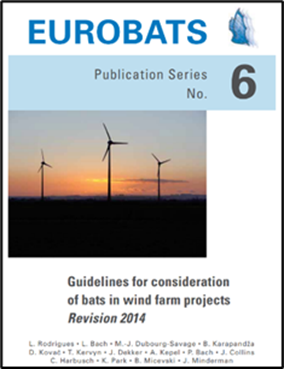There are growing concerns about the impact of renewable energy development on biodiversity. In their latest research, Camille Leroux and colleagues from the National Museum of Natural History of Paris, France, explore how wind turbines impact bat spatial distribution.
World-wide policies have led to a drastic increase in renewable energy developments to tackle climate emergencies, either using solar, tidal or wind energy. While these energies are considered ‘clean’ and could be useful in climate change mitigation, they are not environmentally neutral. Not only do they require large areas for installation, they also impact biodiversity through habitat loss, collision risks, or disturbance.
Wind turbines have received a lot of attention in the last few years — both at sea (offshore) and on land (onshore). They have been show to cause habitat loss for many taxa, either by direct destruction of the habitat or by disturbing surrounding biodiversity. We also know that they can cause fatalities of birds and bats due to collisions, which can be increased by attraction responses from these taxa towards wind turbines.
For bats specifically, both attraction and repulsion have been documented. These behavioural responses to wind turbines are not insignificant: whilst attraction is likely to increase collision risks, repulsion reflects a loss of habitat use. However, we don’t know in which conditions bats are attracted towards wind turbines or repelled by them. As such, we are not able to implement adequate mitigation measures.
In our study, we investigated how bats respond to wind turbine presence along a gradient of distance from an important habitat for bats: hedgerows. To do this, we recorded activity levels in open fields at different distances to hedgerows with and without wind turbines.

We found the activity of all bat groups and species (except for Pipistrellus kuhlii/nathusii) near hedgerows (10–43 m) to be drastically lower under wind turbines than without wind turbines. In contrast, the activity of short-range echolocators was higher under wind turbines when located at 43–100 m from hedgerows, and it tended to be higher for long-range echolocators. Finally, no effect was detected under wind turbines located at 100–283 m from hedgerows for any guild.
This increase of activity measured at the mast suggests that fatality risks near hedgerows could be much more important than what we thought. In short, turbines installed too close to hedgerows could result in local loss of habitat use and increased fatality risks for bats.

Our results corroborate EUROBATS guidelines, which recommend keeping wind turbines at a minimum distance of 200 m from hedgerows. We therefore strongly recommend that these guidelines are followed as it would (1) avoid loss of habitat use in the immediate vicinity of wind turbines and (2) partially reduce fatality risks.
Moreover, the further away we install wind turbines from hedgerows, the more we minimise long-distance repulsion reported in previous studies and, consequently, large-scale losses of habitat use.
Read the full Open Access paper Distance to hedgerows drives local repulsion and attraction of wind turbines on bats: Implications for spatial siting in Journal of Applied Ecology

3 thoughts on “How can we limit wind turbine impacts on biodiversity?”